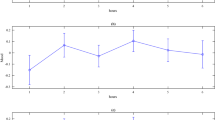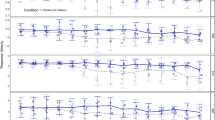Abstract
IT is particularly rewarding to investigate the experience of chronosystole, or time contraction during sympathetic excitation, as this state, which is connected with an increase in metabolic rate, can be elicited at will through psychotomimetic, pyretogenic drugs such as mescaline, marihuana, D-lysergic acid diethylamide (LSD), ‘Psilocybin’1,2. We may define time contraction in terms of an alteration in the signal per noise ratio of the sensor, or in an adaptation of Stroud's3 terminology, an increase in data content. In short, if more events are happening within a chronological time unit, the phenomenon of time contraction is experienced. Hofmann's self-observation, in what may be called the first description of time contraction after a dose of 0.25 mg of LSD (ref. 4), relates “the impression of being unable to move from the spot” on his way horne from the laboratory on a bicycle. Delay's5 systematic description of the psychic effects elicited by ‘Psilocybin’ also refers to experiences which may be considered phenomena of time contraction: “J'ai l'impression que le temps passe plus lentement, qu'il a plus de densité”. “Tout est d'une longuer indéfinissable.”
This is a preview of subscription content, access via your institution
Access options
Subscribe to this journal
Receive 51 print issues and online access
$199.00 per year
only $3.90 per issue
Buy this article
- Purchase on Springer Link
- Instant access to full article PDF
Prices may be subject to local taxes which are calculated during checkout
Similar content being viewed by others
References
Hofmann, A., Ind. J. Pharm., 25, 245 (1963).
Fischer, R., Griffin, F., and Liss, L., Ann. N.Y. Acad. Sci., 96, 44 (1962).
Stroud, J. M., in Information Theory in Psychology, edit. by Quastler, H. (The Free Press, Glencoe, 1955).
Hofmann, A., Triangle (Sandoz), 2, 117 (1955).
Delay, P., et al., in Les Champignons Hallucinogénes du Mexigue, edit. by Heim, R., and Wasson, R. G. (Arch. Mus. Nat. d'Hist. Nat., Paris, 1958).
Wilder, J., Ann. N.Y. Acad. Sci., 98, 1211 (1962).
Kenna, J. C., and Sedman, A., Psychopharmacologia, 5, 280 (1964).
Isbell, H., Psychopharmacologia, 1, 29 (1959).
Breil, M. A., Mschr. Psychiat. Neurol., 125, 193 (1953).
Fischer, R., et al., Arzneimittelforschung (1966).
Ralston, A., and Wilf, H. S., “Autocorrelation and Spectral Analysis”, in Mathematical Methods for Digital Computers (John Wiley and Sons, Sew York, 1960).
Author information
Authors and Affiliations
Rights and permissions
About this article
Cite this article
FISCHER, R., MEAD, E. Time Contraction and Psychomotor Performance produced by ‘Psilocybin’. Nature 209, 433–434 (1966). https://doi.org/10.1038/209433a0
Issue Date:
DOI: https://doi.org/10.1038/209433a0
This article is cited by
-
Psilocybin-induced contraction of nearby visual space
Agents and Actions (1970)
-
Measurement of handwriting area to pressure ratios during psilocybin-induced hallucinations
Agents and Actions (1969)
Comments
By submitting a comment you agree to abide by our Terms and Community Guidelines. If you find something abusive or that does not comply with our terms or guidelines please flag it as inappropriate.



